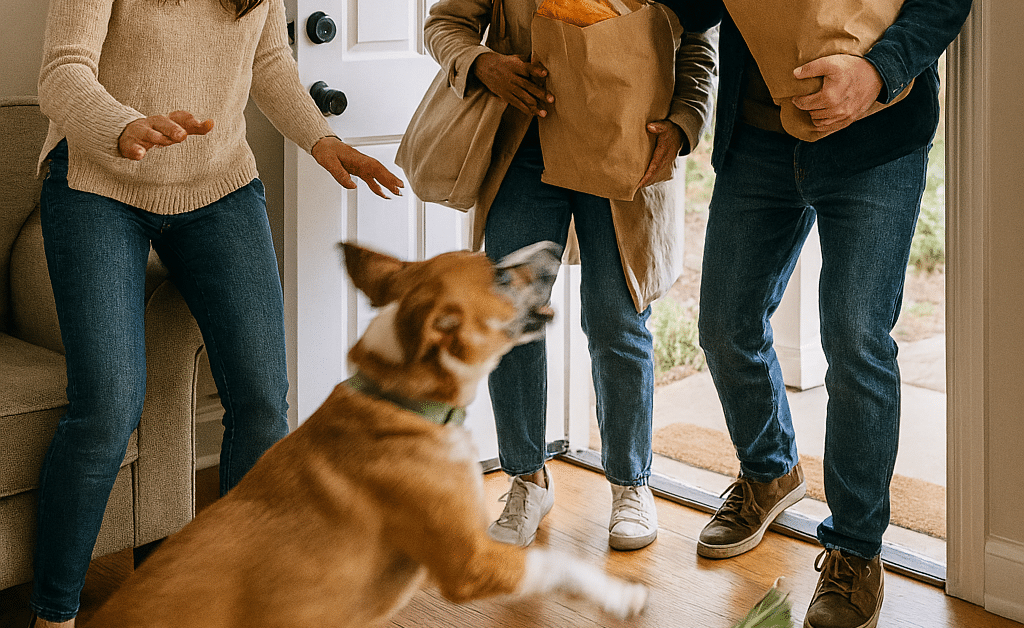
Dog Training: Why It’s Worth the Investment
When people think about professional dog training, the first thing that comes to mind is the cost. A price tag can feel hard to justify at first. However, what often gets missed is the real value training brings to daily life.
Training is not only “sit,” “stay,” and “come.” In addition, it creates a safer, calmer, easier life with your dog. As a result, investing in training now can pay off for years.
The Real Cost of “No Training”
Without clear guidance, dogs repeat what works for them. Small habits can turn into big problems. For example, think about costs that build over time:
-
Chewed belongings — couches, rugs, shoes, even drywall are fair game to a bored or anxious dog.
-
Messes in the house — cleaning fees and carpet repairs add up fast.
-
Risky moments — door dashing, jumping on guests, or running toward the street can cause injuries.
-
Limited lifestyle — you skip patios, parks, and trips because outings feel stressful.
Often, these hidden costs far exceed the value of a thoughtfully designed training plan.
The American Kennel Club (AKC) offers insight into how proper training helps address unwanted behaviors before they escalate. Their article, How to Curb Unwanted Dog Behaviors, emphasizes how consistent, clear training builds predictable, safe behavior—and peace of mind.
Scientific foundations matter too. AKC’s guidance on effective training methods explains how understanding canine learning principles strengthens communication between handler and dog—reducing risk and improving response reliability.
Trusted expert resources in the field of canine behavior and training provide valuable information that supports healthy, well-adjusted dogs and responsible pet ownership.
How Training Saves Money (and Stress)
Training builds habits that prevent damage and reduce risk. Moreover, it gives your dog structure. For example, teaching door manners stops scratched doors, muddy clothes, and spilled groceries. Developing leash skills reduces falls, pulled shoulders, and stressful walks. Crate and settle training protects furniture and helps dogs relax. Reliable recall lowers the chance of a dangerous chase or escape.
As a result, calm, learned behavior protects your home, your budget, and your peace of mind. For more tips, check out our blog on basic obedience skills. You can also review common dog behavior problems to better understand potential challenges.
Everyday Benefits You’ll Notice
A trained dog enjoys more of life—and so do you. For instance, reliable behavior means more walks, hikes, patios, and travel. Visitors come and go without chaos at the door, and your dog makes better choices around distractions and traffic. In addition, clear rules lower stress for dogs and people, while building a stronger bond through better communication and teamwork.
The ASPCA points out that addressing behavior early strengthens the human–animal bond and helps prevent future problems. Therefore, training is not only obedience—it’s a happier life together.
Quick Cost Comparison (Real-World Examples)
Stopping problem behaviors early can save thousands of dollars. For example, a chewed couch can cost $600–$1,200 to replace, door frame repairs may run $150–$400, carpet cleaning $100–$300 per visit, and emergency vet visits from accidents can cost hundreds or even thousands. Clearly, prevention through training is far less expensive than correcting problems later.
Is It Too Late to Start?
Not at all. Dogs can learn at any age. While older habits may take more time to reshape, consistent practice and clear communication work for puppies, adults, and seniors alike. The key is structure, repetition, and patience.
The AKC’s guide to basic dog training explains how even adult dogs can master new skills when training is broken into manageable steps and reinforced regularly. Whether you’re starting fresh or revisiting past efforts, progress is always possible.
“We Tried Training Before and It Didn’t Stick”
This is common. However, training can stall for several reasons. Inconsistent rules confuse dogs; low practice frequency slows progress; too many distractions too soon overwhelm learning; and good habits still require maintenance. As a result, short, frequent sessions with consistent rules and gradual exposure to distractions produce the best outcomes.
Simple Habits That Raise Training Value
You can boost results in a few minutes a day. Decide on one rule for everyone, reward calm behavior, and practice short, frequent sessions. In addition, use real-life scenarios like doorbells, meals, leashes, and car rides to reinforce learning. Level up slowly, protect sleep and exercise, and log wins weekly. Consequently, progress accumulates steadily and reliably.
What Results Can You Expect?
Every dog is different. Even so, most families notice easier walks within weeks, calmer greetings at the door, better focus around new people or dogs, and more relaxing time together at home.
Final Thoughts
Dog training is not just an expense. In conclusion, it is an investment in safety, freedom, and peace for years to come. When you look past the price tag, you see the daily payoff: a calm, confident dog and a home that runs smoother. Start with simple, steady steps. After all, small changes add up to a big difference.
For further reading, explore our full dog training blog collection for tips and insights to improve your dog’s behavior at any age.
